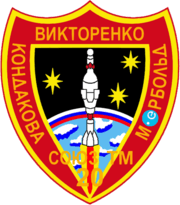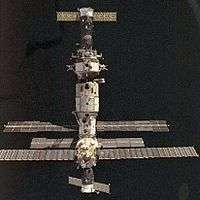Soyuz TM-20
| Mission type | Mir crew transport | ||||
|---|---|---|---|---|---|
| Operator | Rosaviakosmos | ||||
| COSPAR ID | 1994-063A | ||||
| SATCAT № | 23288 | ||||
| Mission duration | 169 days, 5 hours, 21 minutes, 35 seconds | ||||
| Orbits completed | ~2,760 | ||||
| Spacecraft properties | |||||
| Spacecraft | Soyuz 7K-STM No.69[1] | ||||
| Spacecraft type | Soyuz-TM | ||||
| Manufacturer | RKK Energia | ||||
| Launch mass | 7,170 kilograms (15,810 lb) | ||||
| Crew | |||||
| Crew size | 3 | ||||
| Members |
Alexander Viktorenko Yelena Kondakova | ||||
| Launching | Ulf Merbold | ||||
| Landing | Valeri Polyakov | ||||
| Callsign | Ви́тязь (Vityaz' - Knight) | ||||
| Start of mission | |||||
| Launch date | October 3, 1994, 22:42:30 UTC[1] | ||||
| Rocket | Soyuz-U2 | ||||
| Launch site | Baikonur 1/5 | ||||
| End of mission | |||||
| Landing date | March 22, 1995, 04:04:05 UTC | ||||
| Landing site | 50°31′N 67°21′E / 50.52°N 67.35°E | ||||
| Orbital parameters | |||||
| Reference system | Geocentric | ||||
| Regime | Low Earth | ||||
| Perigee | 392 kilometres (244 mi) | ||||
| Apogee | 394 kilometres (245 mi) | ||||
| Inclination | 51.6 degrees | ||||
| Period | 92.42 minutes | ||||
| Epoch | 3 November 1994[2] | ||||
| Docking with Mir | |||||
| Docking port | Core forward | ||||
| Docking date | 6 October 1994, 00:28:15 UTC | ||||
| Undocking date | 22 March 1995, 00:43:08 UTC | ||||

| |||||
The Soyuz-TM crew transports (T - транспортный - Transportnyi - meaning transport, M - модифицированный - Modifitsirovannyi - meaning modified) were fourth generation (1986–2002) Soyuz spacecraft used for ferry flights to the Mir and ISS space stations. It added to the Soyuz-T new docking and rendezvous, radio communications, emergency and integrated parachute/landing engine systems. The new Kurs rendezvous and docking system permitted the Soyuz-TM to maneuver independently of the station, without the station making "mirror image" maneuvers to match unwanted translations introduced by earlier models' aft-mounted attitude control.
Soyuz TM-20 was the twentieth expedition to the Russian Space Station Mir.

Crew
| Position | Launching crew | Landing crew |
|---|---|---|
| Commander | Fourth spaceflight | |
| Flight Engineer | First spaceflight | |
| Research Cosmonaut | Third and last spaceflight |
Second and last spaceflight |
Mission highlights
20th expedition to Mir.
Carried 10 kg of equipment for use by Merbold in ESA’s month-long Euromir 94 experiment program. During automatic approach to Mir’s front port, the spacecraft yawed unexpectedly. Viktorenko completed a manual docking without additional incident.
References
- 1 2 McDowell, Jonathan. "Launch Log". Jonathan's Space Page. Retrieved 9 November 2013.
- ↑ McDowell, Jonathan. "Satellite Catalog". Jonathan's Space Page. Retrieved 9 November 2013.


